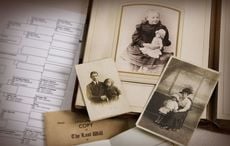I first heard the song “The Three Bells” when I was a boy. The song tells of Jimmy Brown, who was born, married, and died in a small village. The setting was idyllic: located in a valley, among pine trees and beneath mountains. I hadn’t heard or thought of that song for years.
I thought of “The Three Bells” after finding an old, stained photo of my great-grandmother Margaret Horrigan. What does that song have to do with the daughter of poor Irish immigrants who lived near Battery Park in lower Manhattan over one hundred years ago? Margaret too, like many poor children of immigrants, was born, married and died in the same small neighborhood. The setting, however, wasn’t idyllic.
Margaret was born on the corner of Rector and Greenwich Streets in the fall of 1873 to Irish-immigrant parents. Today, little remains from that era of immigrant life. On Rector Street stands an anachronistic, tiny red brick building, the home of a small café and a pizza parlor. The building is the only visible remnant of an earlier era.
Rector Street and the streets that surrounded it constituted a neighborhood at the cusp of its second explosive transformation in fifty years.
Known as Millionaires Row earlier in the nineteenth century, the neighborhood retained few signs of that stately period. With the great influx of immigrants to New York City, the tenement, a building designed as a multifamily worker dwelling, soon became the primary source for housing in the neighborhood.
The residents’ Anglo-sounding names, such as Astor and Todd, reflected the status of those who had come much earlier, but had been replaced by names such as those of my Irish immigrant ancestors, Sullivan, Lyons, and Kelly.
Margaret married my great-grandfather George Gorman on August 17, 1901. She was living at 26 Greenwich Street, two short blocks from where she was born on Rector Street. I can picture Margaret on her wedding day, walking down darkened tenement stairs and onto a crowded street, dominated by the hulking structure of an elevated railway that ran along Greenwich Street.
The “el” was designed to alleviate the problem of clogged streets, but it rendered the street a dark canyon, where saloons and eateries nestled under the trestles. Immigration swelled the ranks of the city’s poor to unprecedented numbers, and downtown New York became notorious for poverty and filth. Horses often bolted through the streets, spraying mud, and much worse, on pedestrians.
On that summer day in August, Margaret would have walked north a few blocks, along the portion of Greenwich Street that was eliminated when the World Trade Center was constructed in the 1960s, to the corner of Greenwich and Barclay Street. A cacophony of sounds would have echoed through the streets.
The clanging of wheels reverberating over cobblestone and the incessant gongs coming from horse-drawn omnibuses were a staple of daily life at the turn of the century.
The influx of immigrants to New York City brought congestion as pedestrians and stages rattled and rumbled through packed thoroughfares. Margaret would have turned onto Barclay Street and entered St. Peter’s Catholic Church, the oldest Catholic parish in New York. There she married my great-grandfather, George Gorman.
Margaret had four children, including my grandfather Allie. She buried one, Lizzie, who died of malnutrition when she was two years old. On New Year’s Eve, December 31, 1906, at the age of thirty-three, my great-grandmother was diagnosed with acute pulmonary tuberculosis. In the nineteenth century, and into the twentieth century, tuberculosis was the leading cause of death in New York City.
Mass migration brought immigrants to cities where they worked in dark, unsanitary factories and lived in crowded housing conditions. The lack of personal hygiene—there was little running water and garbage piled up on the street—caused the spread of communicable diseases such as tuberculosis, cholera, typhoid, and small pox.
Margaret succumbed to her illness six months after she was diagnosed. She was pregnant when she died. She died on Morris Street, midway between Rector Street where she was born and Greenwich Street where she lived.
I’ve often wondered what it must be like to live one’s entire life in a small town, surrounded by the same sights and sounds, day after day. And now I realize that my ancestors, living in the crowded and congested tenements of lower Manhattan, shared a parallel existence with those who have done that. “A bell for birth, a bell for marriage, a bell for death.” I had never considered the universality of their experience.
---
Charles R. Hale was born, raised and educated in New York. He is a former partner of a NYC based consulting firm Hale, Borenstein Ltd. Charles, along with Niamh Hyland, is a cofounder of Artists Without Walls, an organization purposed to inspire, uplift and unite people and communities of diverse cultures through the pursuit of artistic achievement. His film “Walls: We Are Not Forgotten,” about the life of singer Judy Collins, was presented at the 2012 Eugene O’Neill Award ceremony honoring Ms. Collins. In 2013 the City University of New York honored Charles for ”Outstanding Service to New York and Irish America.”




Comments